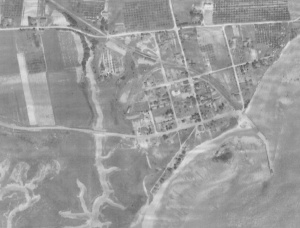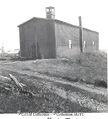Dominion Atlantic Railway Digital Preservation Initiative - Wiki
Use of this site is subject to our Terms & Conditions.
Difference between revisions of "Kingsport"
Dan conlin (talk | contribs) (history and industry) |
Dan conlin (talk | contribs) m |
||
| Line 11: | Line 11: | ||
==History== | ==History== | ||
| − | Previously inhabited by Mi'kmaw and Acadians, Kingsport was settled by New England Planters in the late 18th century. A first known as Indian Point and Oak Point, it became Kingsport in the 19th century as ship yards and a shipping pier made it the leading port in Kings County. Major wooden shipyards built a series of large square-rigged sailing ships from the 1850s to the 1890s. As wooden shipbuilding declined in the face of iron steamships, investors in the area pooled money to bring the railway to Kingsport. The railway arrived in 1889, going into full service in 1890, triggering a major increase in the apple industry. Apple warehouses were built at almost every crossing | + | Previously inhabited by Mi'kmaw and Acadians, Kingsport was settled by New England Planters in the late 18th century. A first known as Indian Point and Oak Point, it became Kingsport in the 19th century as ship yards and a shipping pier made it the leading port in Kings County. Major wooden shipyards built a series of large square-rigged sailing ships from the 1850s to the 1890s. As wooden shipbuilding declined in the face of iron steamships, investors in the area pooled money to bring the railway to Kingsport. The railway arrived in 1889, going into full service in 1890, triggering a major increase in the apple industry. Apple warehouses were built at almost every crossing along the CVR, one every three miles including two inside the wye facing the station at Kingsport. |
| − | The [[Kingsport Wharf]], originally built to serve the shipyard and extended for coast shipping was extended to service ocean steamships with a railway spur along its entire length. Apples, potatoes and lumber were exported while coal, fertilizer, general freight and even Sable Island horses were imported. | + | The [[Kingsport Wharf]], originally built to serve the shipyard and extended for coast shipping was extended to service ocean steamships with a railway spur along its entire length. Apples, potatoes and lumber were exported while coal, fertilizer, general freight and even Sable Island horses were imported. Kingsport was also part of the Minas Basin ferry route for passengers, freight and vehicles carried out by a series of steamships, the [[SS Evangeline]], [[SS Prince Albert]] and later the [[MV Kipawo]] which connected Kingsport to Parrsboro and [[Wolfville]] from 1890 until 1940. |
| − | Kingsport | + | A number of industries operated in Kingsport following the railway's arrival including a saw mill, moulding mill, two boat builders and in the first few years of the railway, a ship repair operation in the old shipyard. While the mills eventually declined, rail related tourism grew as several hotels such as the Sunnyside Inn and the Longspell Inn were built for summer tourists and a colony of summer cottages grew around the village and beach. |
| + | |||
| + | The railway operations at Kingsport centred on a large wye with a [[Kingsport Enginehouse|single stall enginehouse]] where the branch line locomotive received light servicing and stayed overnight. Because of the short distance to [[Kentville]], there were no water or coaling facilities. Kingsport was home to many of the regular train crews on the branchline and also a summer home to some DAR employees who owned cottages there. | ||
==Facilities== | ==Facilities== | ||
Revision as of 19:33, 4 July 2016
Kingsport, Nova Scotia
- Subdivision Kingsport, Mile 13.6
Previous Station: Pereau
Kingsport was the eastern terminus of the Cornwallis Valley Railway branchline. It served as a busy shipping point and interchange between rail and ocean transport from 1890 until 1962.
History
Previously inhabited by Mi'kmaw and Acadians, Kingsport was settled by New England Planters in the late 18th century. A first known as Indian Point and Oak Point, it became Kingsport in the 19th century as ship yards and a shipping pier made it the leading port in Kings County. Major wooden shipyards built a series of large square-rigged sailing ships from the 1850s to the 1890s. As wooden shipbuilding declined in the face of iron steamships, investors in the area pooled money to bring the railway to Kingsport. The railway arrived in 1889, going into full service in 1890, triggering a major increase in the apple industry. Apple warehouses were built at almost every crossing along the CVR, one every three miles including two inside the wye facing the station at Kingsport.
The Kingsport Wharf, originally built to serve the shipyard and extended for coast shipping was extended to service ocean steamships with a railway spur along its entire length. Apples, potatoes and lumber were exported while coal, fertilizer, general freight and even Sable Island horses were imported. Kingsport was also part of the Minas Basin ferry route for passengers, freight and vehicles carried out by a series of steamships, the SS Evangeline, SS Prince Albert and later the MV Kipawo which connected Kingsport to Parrsboro and Wolfville from 1890 until 1940.
A number of industries operated in Kingsport following the railway's arrival including a saw mill, moulding mill, two boat builders and in the first few years of the railway, a ship repair operation in the old shipyard. While the mills eventually declined, rail related tourism grew as several hotels such as the Sunnyside Inn and the Longspell Inn were built for summer tourists and a colony of summer cottages grew around the village and beach.
The railway operations at Kingsport centred on a large wye with a single stall enginehouse where the branch line locomotive received light servicing and stayed overnight. Because of the short distance to Kentville, there were no water or coaling facilities. Kingsport was home to many of the regular train crews on the branchline and also a summer home to some DAR employees who owned cottages there.
Facilities
Kingsport Station, north side of main line
Siding for two apple warehouses opposite station, south side of main line:
- Section House at east switch of wye
Wye
Spur line to Kingsport Wharf
- Siding at wharf, abandoned by 1911
Waiting room/freight shed and lighthouse at end of wharf
Features
Gallery
Kingsport Wharf, high and low tide views, with flatcars and gondola on wharf siding, circa 1900.
Combine No. 24 (behind engine) and Combine No. 31 with Locomotive No. 12 in a detail of a Kingsport Wharf photo, c. 1911
Ephraim Hiltz inside the Kingsport Enginehouse with locomotive No. 21, circa 1915.
DAR Inspection Car on the Kingsport Wharf, circa 1914-18
Kingsport Wharf and freight shed, Summer 1940.
DAR locomotive No. 470 with Train No. 11 at the Kingsport Station, circa 1942.
The Kingsport Wharf, the final terminus of the CVR, showing the second DAR freight shed on the wharf in the last days of the subdivision, circa 1960.
References and Footnotes
- Dominion Atlantic Railway Employee Time Table September 25, 1949, Library and Archives Canada, pmp -HE.2804 DC










